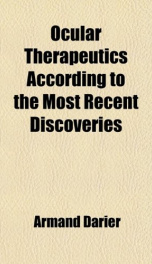ocular therapeutics according to the most recent discoveries

Purchase of this book includes free trial access to www.million-books.com where you can read more than a million books for free. This is an OCR edition with typos. Excerpt from book: LECTURE III. Summary. The mode of action and of penetration of substances injected beneath the conjunctiva.âAbsorption by the cornea and the conjunctiva.âThe penetration of fluoresceln into the media of the ej'e.âClinical work and experimentation.âCyanide of mercury and chloride of sodium.âTrophic and antiseptic action.âThe technique of subconjunctival injections.âThey may be rendered painless by acoine.âClinical indications and contra-indications. The eye lends itself admirably to local therapeutics, because of the arrangement of its lymphatic system, which is made up of spaces communicating readily one with another. It is well known that atropine, even in feeble solution, instilled into the conjunctival sac, is resorbed by the ocular lymphatics, and penetrates into the contents of the anterior chamber. Mydriasis may, we know, be induced in a second animal by putting into its eye a few drops of this aqueous humour. Pfliiger has proved the same thing by injecting under the conjunctiva a solution of fluorescem, a stain having great powers of diffusibility. He has observed, under such circumstances, that not only does the aqueous humour become tinged, but also the cornea and the crystalline lens. Bellarminof, by simple instillations into the conjunctival sac, has also been able to colour the aqueous humour with fluorescein. But it has been objected that salts of mercury form with the albuminoids of the body insoluble compounds unable to penetrate into the ocular media. In order to prove the point, one has made subconjunctival injections of sublimate or of cyanide of mercury in the rabbit, and several-hours afterwards has failed to find any trace of mercury in the aqueous humour. But the seeking for a mercurial reaction in a solution as dilute as it must be in...
Info about the book
Author:
Series:
Unknown
ISBN:
1905740018
Rating:
4.5/5 (1)Your rating:
0/5
Languge:
English
Users who have this book
Users who want this book
What readers are saying
What do you think? Write your own comment on this book!
write a commentGenre
if you like ocular therapeutics according to the most recent discoveries try:
Other books by this author
Do you want to read a book that interests you? It’s EASY!
Create an account and send a request for reading to other users on the Webpage of the book!

